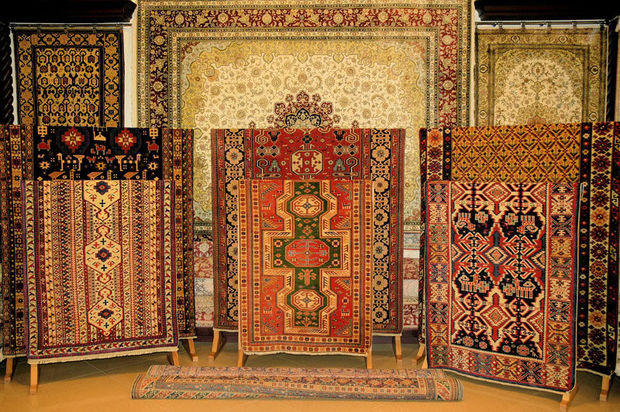Azerbaijan carpet making history dates back to the Bronze Age, that is, 5,000 years ago. This art reflects the nature, history, and way of life of the country. According to historical sources, Azerbaijan was one of the important centers for the production of pile and home are woven carpets in the Middle Ages in the East. Azerbaijani carpets are famous all over the world as an example of ancient art. Studies show that the north-eastern part of Azerbaijan was the center for the production of high-quality carpets in the V-VII centuries. Since the Middle Ages, it has played the role of a means of trade around the world. Today, there are countless types of carpets in the country, rich in various weaves and ornaments.
This valuable treasure is a unique collection of the State Museum of Azerbaijani Carpets and Folk Applied Art named after Latif Karimov. This museum contains the most exemplary works of modern artists and folk artists, as well as examples of ancient, invaluable carpets and folk arts created by the people of Azerbaijan, which are the bearers of national culture and art. The museum is the largest carpet collection in the world in terms of the value and importance of carpets, the first, authoritative, specialized museum in the field of carpet art.
The development of carpet weaving in Azerbaijan is described in the works of ancient historians such as Herodotus, Claudius Elian, Xenophon, as well as medieval Arab historians and Azerbaijani poets Nizami (XII century), Khagani (XII century).
In the XIII-XIV centuries, many carpets and carpet products were exported from Azerbaijan to foreign countries. These carpets, which attract attention with their delicate ornaments, elegant and delicate patterns, are reflected in the works of famous European artists. 15th-century Dutch artist Hans Memling’s painting “Mary with her baby” depicts the Shirvan carpet, Van Eyck’s “Holy Mary” carpet “Zeyva” carpet, German artist Hans Holbein’s (15th century) work “Ambassadors” depicts the “Gazakh” carpet. Pearls of carpet art created by Azerbaijani folk artists have been exhibited in many museums around the world for centuries: the Metropolitan of New York, Victoria, and Albert of London, the Hermitage of St. Petersburg, the Louvre of Paris, and others. decorated. Also, today in the State Museum of Azerbaijani Carpets and Folk Applied Art you can get acquainted with rare examples of these pearls of art. In the exposition of the museum, carpets belonging to the classical carpet schools of Azerbaijan such as Guba, Baku, Shirvan, Ganja, Gazakh, Karabakh, Tabriz attract attention for their composition and ornamental structures, as well as color solutions. From the carpets woven in Guba – “Pirabadil”, “Gimil”, “Sirt-Chichi”, the elegance of the details of painting and pattern elements, the seemingly woven elements, the insignificant elements, the small cartoons, the compact color gamut. Of the Shirvan carpets – “Mugan”, “Shilyan” – a kind, similar to our first ancient carpets. In these carpets, ancient carpet compositions are realized with a serious rhythm, calm color prevails. Karabakh carpets – “Khanlig”, “Malibeyli”, “Lampa” – high compositional skills, unimaginable fantasy, colorful colors stand in the foreground. Among the carpets made in Baku – “Khila – Buta”, “Novkhani”, “Fatmayi” – there are elegant cartoons, intricate ornaments. The geometric style of the patterns is preferred in the carpets of Ganja and Gazakh schools, such as “Fakhrali”, “Shikhli”, “Borchali”, “Gachagan”, “Gadim Goycha”, “Demirchiler”, which are based on a very large condition. From the Tabriz carpets – “Sarabi”, “Afshan”, “Lechek – Orange”, the decor of round or spiral plastic forms create an idea of the eternity, beauty, and rhythm of life of the world. The State Museum of Azerbaijani Carpets and Applied Arts has collected such unique examples of Azerbaijani art in its collection. In the exposition of the museum, it is possible to learn different methods of weaving, more than 10 types of weaving, its secrets, and get acquainted visually.
A number of measures are being taken to make the museum internationally recognized. On the basis of the rich material and scientific base of the museum, I, II, and III international symposiums on “Oriental carpet art”, “Azerbaijani carpet art” and “Azerbaijani carpet and folk applied art” were held in 1983-1988 and 2003. On February 14, 2007, the 4th International Symposium on “Azerbaijani Carpet, Art” and the exhibition “Azerbaijani Carpet” dedicated to the 100th anniversary of Latif Karimov were held at the UNESCO headquarters in Paris.
In order to promote the cultural heritage of Azerbaijan in the near and far abroad, the museum has organized exhibitions on carpets and folk arts in the country and in more than 30 foreign countries. Among them are France, Austria, Sweden, Denmark, Belgium, India, Japan, Israel, Great Britain, Cuba, Iran, the Netherlands, Cambodia, Madagascar, Turkey, and others. countries can be shown.




